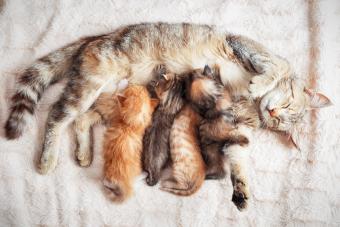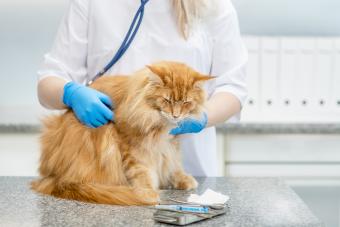
As your kitty nears the end of her pregnancy, it's natural to wonder how long it takes a cat to give birth. From beginning to end, labor usually takes about six to eight hours, with an active labor phase of up to 40 minutes for each kitten born.
How Long Is a Cat in Labor?
There are three stages to feline labor, each lasting a different amount of time. The length of the overall delivery will also be affected by the number of kittens born.
Stage 1 Labor - Getting Ready
During this stage, the cat will start looking for a place to deliver her kittens. She may lick her genitalia, act restless, or stop eating. This stage can last for 24 hours to 36 hours.
Stage 2 Labor - Kitten Births
This stage occurs when powerful uterine contractions push a kitten into the birth canal, the fetal membranes rupture, and the kitten is born. This can happen in as few as five minutes, but it should not take any longer than 30 minutes.
Stage 3 Labor - Expelling the Placenta
After each kitten is delivered, the placenta should be expelled from the uterus. This will look green to black in color and, according to The Cat Care Clinic, the mother cat will usually eat it. The placenta is typically passed immediately after the kitten, or at least within five to 10 minutes.

How Long Between Kitten Births?
After each kitten is delivered, the cat will cycle through stages two and three until all the kittens have been born. Intervals between kitten births can be from about 10 minutes to an hour, although another kitten may be born immediately after the placenta is expelled, or it may take a little longer than an hour.
Most cats have four to six kittens in a litter, although there can be variations between breeds and due to genetic differences.
How Long Do Cats Take to Give Birth?
The total process, once your cat is in stage 2 labor, takes two to six hours for most cats. Some cats may even go through a resting stage that can last 24 to 36 hours before continuing birthing remaining kittens.

Labor and Delivery Breed Differences
While the process of labor and delivery is similar in all cats, there can be some variation in how long it takes for different breeds of cats to have their kittens. Breeds with narrow and tapered heads such as Siamese are usually delivered more quickly, while snub-nosed breeds, such as Persians, have wider heads that can lead to a more difficult birth.
Some breeds may require a cesarean section if the kittens are too large.
When to Intervene in Your Cat's Labor
You should only involve yourself in your cat's labor if something is not moving along properly. As The Cat Care Clinic notes, a cat may need assistance if:
- She has had over 20 minutes of continuous contractions without a kitten being born
- More than four hours have passed between kittens, and you expect more kittens
- If a kitten is partially out but the mother cat is too tired to continue pushing
- Constant bleeding occurs
- Your cat has pale gums
- Labored breathing is present
- The mother does not clean the membranes off the kitten's face
- The mother does not keep kittens warm
Interrupted Labor in Cats
In rare instances, there may be a delay between kittens in which the mother rests and the cat may enter interrupted labor. Generally, you would not know your cat is in interrupted labor unless you took her to the vet and the vet performed an ultrasound.
Interrupted labor is fairly uncommon. During interrupted labor, she will groom the kittens, relax, and may start eating again before continuing the delivery. This rest period can even last for 24 to 36 hours. However, there is no way to know whether your cat is in interrupted labor or there is an issue, and so an evaluation by a vet is ideal if she hasn't had a kitten in four hours and you expect more.
When to Bring Your Cat to the Vet
Aside from interrupted labor, the following are other cases that require veterinary attention:
- Stage 1 is lasting longer than 24 hours without the cat straining
- Mother cat appears overwhelmingly weak
- Green-ish discharge with a kitten
- Kitten is stuck, but can't be removed with gentle pulling
Before your cat goes into labor, put your emergency veterinarian's phone number where you can access it quickly, if necessary.
Cats Having Babies
If you suspect something is wrong during your cat's labor, contact an emergency veterinarian to walk you through any steps to ensure a healthy delivery. It may become necessary to take her to the vet for a C-section. However, for most cats, this isn't necessary.







